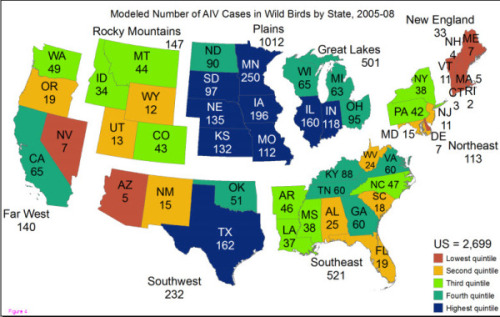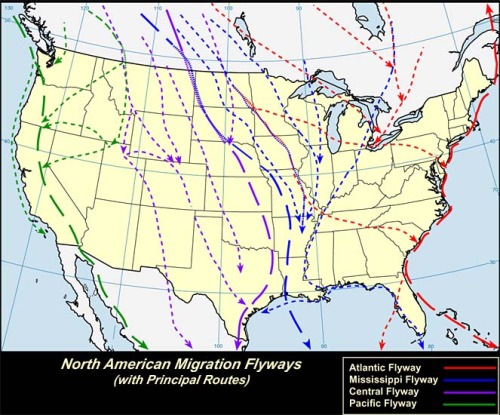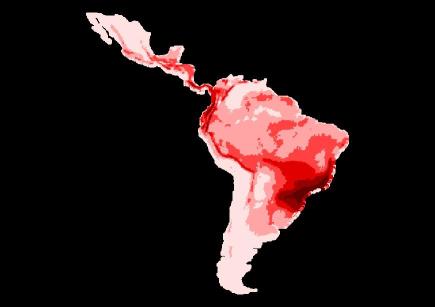Entries in bird flu (23)
Making sense of the recent flu news
It has been a long time since I blogged anything about the flu. For starters, I am busier than ever at work, which cuts severely into my blogging time. But also because I just have not felt the muse. The swine flu pandemic was blessedly mild overall, although there are thousands of families still coping with the loss of a loved one due to H1N1/2009 who would harshly disagree with my assessment. But it wasn't 1918, so we breathed a sigh of relief.
There are many seemingly divergent storylines currently out there, which I will just list at random. I am not so sure they are not somehow interconnected, however.
First has to be the continued number of human bird flu infections and deaths in Egypt. Overlaying this ongoing problem is the sudden departure of Mubarak, the takeover by the Egyptian military, and what this portends for both transparency and NAMRU's operations within the nation.
Second is the realization that this year's seasonal flu vaccine was way off the mark. I began to notice last month that my employees were getting sick from flu, and I knew they had received their vaccinations in the late fall. My deputy, in fact, was tested type A-positive last month. That's pretty specific. Here in Tallahassee, doc-in-the-box and emergency rooms were positively overrun with flu cases. Things are looking better, but the WHUMP! of flu cases in January was much more severe than at the same time last year. And last year was the dang pandemic! Almost everyone who got flu this year who I am personally acquainted with, had, in fact, received the vaccine months prior.
Third is the ongoing Siege of Japan by H5N1 in poultry. We all have read the articles about the culling of hundreds of thousands of birds in Japanese poultry farms. this has spread to the mainland, especially South Korea.
What is clear to me is that the H1N1/2009 pandemic was not sufficient to push the other subtypes off the radar. This runs contrary to previous pandemics where a dominant substrain was capable of, and able to, sufficiently supplant the previous Big Dog of Flu. H1N1 was replaced by H2N2, which was replaced by H3N2, and so on. Swine flu was not able to eradicate H3N2, nor was it able to eradicate B. for that matter, I do not know what research existed prior to the mid-1950s to actually track Influenza B. for all I know, Influenza B has been around since the Chinese domesticated ducks some 4,000 years ago.
Or, since B mutates more slowly than A, and is therefore not capable of producing pandemics (so says Wikipedia), it is not subject to the King of the Mountain game like Influenza A.
But someone apparently blew the call on the vaccine this season. I get the feeling the only strain they got right was, in fact, the pandemic strain!
The other strain that H1N1/2009 did not push off the radar is H5N1. In fact, so far this year, bird flu activity seems to be much more intense than at the same time last year. Human cases and deaths in Egypt seem to be at the same levels as last year, but H5N1's overrunning of the Japanese poultry industry is disconcerting.
Finally, there seems to be some concern that this year's flu outbreaks are more severe than last year's. Again, this is not scientific, but my people got hit and hit hard by the virus. Their symptoms were severe, with one person requiring hospitalization. In one case Tamiflu did nothing, although there is a chance it was not administered in time.
H1N1 had a comeback in the late 1940s and early 1950s, with several epidemics (the Liverpool Flu of 1951, for instance) that were considered equal to, or more severe than, the 1918 pandemic, depending on location. Shortly afterward, H2N2 (re)appeared, seemingly wiping H1N1 off the face of the Earth.
I openly wonder if the appearance of swine flu in 2009 was, in fact, the Beginning of the End of H1N1 as it was in the 1950s, and we are at the brink of the introduction of a different substrain of flu.
Songbirds, not just fowl, represent avian flu threat to US
Over at Flutrackers, there is a thread regarding the prevalence of avian influenza in American birds.
Avian influenza virus (AIV) is an important public health issue because pandemic influenza viruses in people have contained genes from viruses that infect birds. The H5 and H7 AIV subtypes have periodically mutated from low pathogenicity to high pathogenicity form. Analysis of the geographic distribution of AIV can identify areas where reassortment events might occur and how high pathogenicity influenza might travel if it enters wild bird populations in the US. Modelling the number of AIV cases is important because the rate of co-infection with multiple AIV subtypes increases with the number of cases and co-infection is the source of reassortment events that give rise to new strains of influenza, which occurred before the 1968 pandemic. Aquatic birds in the orders Anseriformes and Charadriiformes have been recognized as reservoirs of AIV since the 1970s. However, little is known about influenza prevalence in terrestrial birds in the order Passeriformes. Since passerines share the same habitat as poultry, they may be more effective transmitters of the disease to humans than aquatic birds. We analyze 152 passerine species including the American Robin (Turdus migratorius) and Swainson's Thrush (Catharus ustulatus).
Methods
We formulate a regression model to predict AIV cases throughout the US at the county scale as a function of 12 environmental variables, sampling effort, and proximity to other counties with influenza outbreaks. Our analysis did not distinguish between types of influenza, including low or highly pathogenic forms.
Results
Analysis of 13,046 cloacal samples collected from 225 bird species in 41 US states between 2005 and 2008 indicates that the average prevalence of influenza in passerines is greater than the prevalence in eight other avian orders. Our regression model identifies the Great Plains and the Pacific Northwest as high-risk areas for AIV. Highly significant predictors of AIV include the amount of harvested cropland and the first day of the year when a county is snow free.
Conclusions
Although the prevalence of influenza in waterfowl has long been appreciated, we show that 22 species of song birds and perching birds (order Passeriformes) are influenza reservoirs in the contiguous US.
OK, insightful analysis time. We always associate bird flu with ducks, or chickens, or turkeys or geese, but rarely do we associate it with songbirds and other smaller birds. This study makes a clear association between those birds (called "passerines") and bird flu.
The distribution of those avian flu cases is seen in this map (thanks Laidback Al!):

Now let us look at a map of the principal migratory bird routes over North America:

There is a veritable swarm of migratory bird routes over the Great Plains and Mississippi River delta, and a very strong west coast migratory route. So it is no coincidence, in my mind, that these migratory superhighways also contain the areas where avian flu has been most strongly detected since 2005.
Now you also notice those "down arrows" leading South of the Border. This map helps illustrate what happens south of us:

We've got birds encroaching from the south as well as from the north. This does not just figure into the avian flu equation: There is this little thing called a major dengue fever epidemic that is raging in many, if not most, South American nations. And as I mentioned recently, Key West, Florida has enough dengue in it to sicken a man this year.
This all leads into the current status of H5N1 sentinel activity. With massive budget cuts, waning interest, and competition for attention from swine flu and other diseases, do we have as good a handle on things as we did in 2006 and 2007? I would like to think so, but I doubt it.
Imagine the encounter: A researcher goes into his/her supervisor's office, requesting additional funds for H5N1 monitoring. What, the supervisor says? You want me to divert $$ from certain necessary projects over to bird flu monitoring? All while my departmental budget is being cut to ribbons?! No stinking way!
Or words to that effect. I wish it were not so, but I am pretty certain I am right.
In the midst of all this, the Mexican government recently issued an alert to be watchful for an H5/H1 hybrid virus. My first impulse was to say, What do they know? What have they heard? But is may have been nothing more than speculation. Nonetheless, vigilance is important, now more than ever. For H1N1v may not have been the pandemic everyone feared, but it was substantial in terms of its effect on the young; far worse than, say, 1977. Yet H1N1v, being 1/3 avian, can still hang out with avian flu viruses and reassort. It is precisely this scenario that should cause us to view this latest report with concern.
Why Na Tao matters, despite apparent lack of human bird flu transmission
A reader of this Blogsite, Jonathan Singleton, asked me to comment on the recent proMED report regarding Na Tao, Vietnam. As you may know, Na Tao is at the heart of a possible cluster of human cases of bird flu. My previous two blogs have covered this developing situation.
The proMED report in question is below.
Influenza A (H5N1) is not transmitted from human to human
---------------------------------------------------------------------------
Yesterday afternoon [14 Apr 2010], at a meeting of the National Steering Committee for pandemic influenza control and prevention, Dr Tran Nhu Duong, Deputy Director of the National Institute of Hygiene and Epidemiology confirmed that influenza A (H5N1) has not been transmitted from human to human.
The investigation of the Institute on 2 cases of influenza A (H5N1) in Na Tao village, Nhu Co commune, Cho Moi District, Bac Kan province did not detect human to human virus transmission.
Reports of two investigation teams of the Institute in Bac Kan showed that the two patients were living about 100 meters apart, and they had never been in direct contact with each other.
All 33 people who had contact with the patients, including relatives, visitors, neighbors, nurses, and physicians, were tested and monitored for 16 days. There has been no case with symptoms of the disease. All the test results were negative.
Communicated by:
PRO/MBDS
As we now know, there are three suspected human cases, not two. But that is not material to our discussion. What is material is that two persons, living about a little more than a football field's distance apart, contracted H5N1 bird flu.
The report seems to conclude that distance alone, coupled with a lack of direct contact of one with another, eliminates the possibility of human-to-human (H2H) transmission. That sounds logical enough.
But the larger issue -- the proverbial elephant in the room -- is this: Has the virus itself changed enough in Na Tao, Vietnam, to allow for an easier method of transmission from avian to human respiratory cells? If so, that disclosure would prove to be almost as big (and ultimately more potentially troublesome) than another H2H cluster.
That is a question that the Vietnamese report does not answer.
Let's consider the facts. Three persons in one district contract bird flu. Apparently they all contracted it via contact with diseased poultry. That tells me that either the virus in that area of Vietnam is more potent, and/or the ability of the virus to favor human epithelial cells as much as it favors chicken epithelial cells.
We all know from reading the research papers that this proclivity toward one species or another is primarily driven by temperature. The fact that both diseased poultry and diseased villagers have been detected in a cluster bears investigating by the WHO. For a cluster is a cluster whenever you get multiple persons in a close area, H2H or no H2H. Three B2H bird flu cases in one hamlet should be significant enough to want to gather many samples and look at them very, very carefully.
Vietnam's Na Tao hamlet: Ground Zero for latest bird flu cluster
The world press is beginning to focus on the province of Bak Kan (or Bac Can), Vietnam. Bak Kan is in the extreme north of Vietnam, near the Chinese border. Last week, I blogged on the potential H5N1 bird flu cluster that was threatening to emerge within that province. Just scroll down to read my previous blog.
Following my blog, a second story appeared regarding a second human infection. It was dated at 6:01 PM, 04/09/2010. It appears below, and the link to the VOV story is in the headline:
Another A/H5N1 infection case reported in Bac Kan
The healthcare centre in Cho Moi district has reported nine suspected cases, eight of them from Na Tao hamlet. (bold mine) All nine showed symptoms of high fever, breathing difficulty and coughing.
The first A/H5N1 case was detected in Bac Kan on April 5. The patient, Trung Van Hoa, 22, was also from Na Tao hamlet.
At present, local authorities and health agencies are intensifying emergency measures to sterilise infected areas and strictly monitor new outbreaks of the disease.
Cho Moi district has been given 700 doses of Tamiflu vaccine(bold mine) and enough medical equipment to ensure that necessary checkups and treatment can be provided to local patients.
Now today, a copyrighted story has appeared via the Canadian Press. It has also been picked up by AP and has gone worldwide. Here is that story:
Bird flu sickens 2 in Vietnam; 11 others quarantined, recovering from flulike symptoms
By Tran Van Minh (CP) – 5 hours ago
HANOI, Vietnam — Two Vietnamese from a poor, mountainous area have been infected with bird flu, and 11 others were quarantined with flulike symptoms, health officials said Tuesday.
A 22-year-old man and a 27-month-old girl remain hospitalized after testing positive for the H5N1 virus, said Hoang Van Linh, deputy director of northern Bac Kan province's health department. He said the 11 others, some of whom were relatives of the confirmed cases, had fallen ill with fever, coughing and shortness of breath.
They were given the antiviral Tamiflu and have since recovered. He said they were tested for bird flu, but the results have not come back.
Dead chickens were reported at the homes of the two patients, and the toddler's family is believed to have slaughtered and eaten some of the infected poultry, according to the Ministry of Health's Web site. Ly Quoc Khach, an infectious disease official from the provincial health department, said all 11 people, members of the Tay and Nung ethnic minorities, had contact with the sick birds, and he said he did not believe there would be any reason to fear possible human-to-human transmission if they did test positive.
The 22-year-old man remains on a respirator after being hospitalized April 2, while the toddler, who was admitted two days later, is in stable condition, Hoang said. All of the sick people's homes in Ma Tao commune have since been disinfected, and the infected poultry have been slaughtered, Ly said.
Vietnam has been hit with a spate of fresh H5N1 outbreaks among poultry, and two people have died from the disease this year, according to the World health Organization, which confirms 59 deaths since late 2003.
The disease remains rare among people, with most cases linked to direct contact with infected poultry. But experts have long feared the virulent virus could mutate into a form that allows it to spread easily among people, possibly igniting a pandemic.
Copyright © 2010 The Canadian Press. All rights reserved.
OK, time for award-winning commentary again. Note that the Vietnamese press is listing three -- NOT two -- confirmed H5n1 cases. Note also that the VoV article speaks of a Tamiflu blanket that has been applied over the entire district of Cho Moi, which includes the hamlet (and apparent epicenter of this bird flu outbreak), Na Tao.
Note that the total of suspected human bird flu patients is up to 11. If we include the three previous cases, we have as many as 14 possibles. This would make this the largest bird flu human cluster since 2008.
Bird flu is cropping up all over Asia again. China is seeing a re-emergence, no doubt facilitated by illegal trade in smuggled birds (Google my blog of, oh, I dunno, maybe 2007 on that topic). A veritable Ho Chi Minh trail of smuggling activity exists between China and Vietnam, the irony of which is not lost on Americans.
But I digress. The Vietnamese government has acted quickly and decisively on the issue of Bak Kan. They have applied a Tamiflu blanket over an area comprising 700 villagers. They have eleven villagers in quarantine with clear symptoms of influenza, and three confirmed human cases.
The next thing to look at is the timeline. The first human case in Bak Kan was March 30th of this year. The toddler was admitted two days after the first case. The third confirmed case was "four or five days before being diagnosed with the virus," meaning some time possibly between the 30th of March and the 5th of April (the story was written on the 9th).
The epicenter of the epicenter appears to be a commune within the hamlet. Now I suppose it is possible that people would have eaten diseased poultry at the same time. But the onset of symptoms is staggered by several day between the first and third cases. This would cause me to speculate that you cannot exclude human-to-human contact. And the simple fact that 700 surrounding villagers are currently on Tamiflu as a preventative would seem to support that hypothesis.
Hopefully, the reasonably transparent Vietnamese government will be very forthcoming with samples of this virus. In light of the fact that H1N1v, aka swine flu, is still traversing those same remote hamlets of Asia, and in light of the jarring re-emergence of H5N1 bird flu across eastern Europe and Asia, we need to know: Has bird flu mutated?
All eyes on Vietnam for potential human bird flu cluster
 Yesterday, Vietnam confirmed yet another human bird flu case. This time, however, this case bears watching, because it could signal something far more disconcerting than just a single human case.
Yesterday, Vietnam confirmed yet another human bird flu case. This time, however, this case bears watching, because it could signal something far more disconcerting than just a single human case.
From the proMED report:
The Director of the Bac Kan provincial Health Department, Nong Quoc Chi, confirmed an A (H5N1)-infected case on [5 Apr 2010]. The patient, [male], 22, from Na Tao hamlet, Nhu Co commune, Cho Moi district, is currently in critical condition. He is being treated at the [National Institute of Tropical and Infectious Diseases]. The patient got sick on [30 Mar 2010] with symptoms of high fever and cough. He was admitted to Bac Kan provincial hospital, and then sent to the [National Institute of Tropical and Infectious Diseases] on [3 Apr 2010] where he tested positive for the lethal strain of A (H5N1) virus.
At present, 4 other people in Nhu Co commune show similar symptoms of high fever and cough. They are under quarantine and being treated at Bac Kan provincial hospital.
 The patient in question was taken ill on the 30th of March, and then sent to Hanoi when his condition worsened. The four suspected human bird flu cases are currently in quarantine at the provincial hospital in the provincial capital of Bak Kan. (Or Bac Can, as shown on map at left).
The patient in question was taken ill on the 30th of March, and then sent to Hanoi when his condition worsened. The four suspected human bird flu cases are currently in quarantine at the provincial hospital in the provincial capital of Bak Kan. (Or Bac Can, as shown on map at left).
There are many unanswered questions. The most obvious of these is whether these four suspected cases are bird flu, or swine flu?
If these cases are indeed bird flu, has there been human-to-human chain transmission, or were these people all infected during the same timeframe by a single vector? Were they all infected by sick poultry, or were they sickened by a human infection?
OK, let's assume these four people were all H1N1/swine flu infections. That is not good news! That would mean that, once again, bird flu and swine flu had "rubbed elbows" in rural Vietnam. Search my Blogsite for the earlier known case, back in 2009.
According to the Vietnamese Department of Preventive Medicine and the Environment, there are no outbreaks of H1N1 anywhere in Vietnam. From VOA News:
No more A/H1N1 outbreaks in Vietnam
At a meeting reviewing the flu epidemic situation in Hanoi on March 31, the Deputy Director of the Department of Preventive Medicine and the Environment, Tran Khac Phu, confirmed that 11,208 people in the country had been infected with the virus as of March 31 and 58 of them had died.
Regarding the A/H5N1 flu, Phu said that there were no more confirmed cases last week, and the total number of such cases so far this year stands at five, including two deaths.
The A/H1N1 virus epidemic appears to have subsided and the country has not detected any mutations in the virus, said Associate Professor Dr. Nguyen Tran Hien, Director of the Central Institute of Hygiene and Epidemiology.
However, Hien urged localities to closely monitor for the A/H5N1 virus as it is still being found on poultry in several areas.
According to the World Health Organisation (WHO), by March 30, there had been 492 confirmed cases of A/H5N1 infection in 15 countries, resulting in 291 deaths.
Vietnam is actively looking for bird flu cases, so perhaps this is why they feel so confident that no H1N1 outbreaks have occurred. But this may be at odds with the WHO Vietnam report of February 10, 2010. that WHO report stated, matter-of-factly:
Pandemic (H1N1) 2009 is continuing to spread throughout Viet Nam. The spread of  the virus to all countries, worldwide, is considered inevitable.
the virus to all countries, worldwide, is considered inevitable.
As of 10 February 2010, Viet Nam's Ministry of Health has received reports of 11,186 laboratory confirmed cases, including 58 deaths. (Bold WHO's)
It is important to note that this pandemic is currently referred to as of “moderate” severity based upon the global situation. The overwhelming majority of patients are recovering without the need for hospitalization or even medical care, the levels of severe cases are similar to the levels we expect for seasonal influenza, and the health care systems are able to cope with the number of people seeking care.
With the increasing spread of H1N1 in Viet Nam, we expect that there will be a number of people who have serious complications and some will die.
All-righty then! Is Vietnam's swine flu rate climbing or falling? This is not an unimportant question, because it is becoming apparent that Vietnam, more than any other nation save Egypt, may have the potential to be that flashpoint where H5 and H1 reassort. Vietnam has had, to date, prior to this report, 5 bird flu cases with 2 deaths. Egypt, in contrast, has had 18 human bird flu cases with 6 deaths. Both areas are of huge concern.
Let's all keep our eyes on this developing situation.
